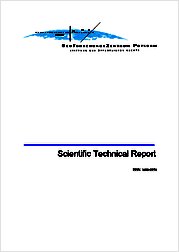Airborne navigation and gravimetry ensemble & laboratory
ANGEL ; introduction and first airborne tests
| dc.contributor.author | Meyer, Uwe | |
| dc.date.accessioned | 2010-10-28T18:46:49Z | |
| dc.date.available | 2010-10-28T18:46:49Z | |
| dc.date.issued | 2003 | |
| dc.identifier.uri | http://hdl.handle.net/11858/00-1735-0000-0001-32F4-1 | |
| dc.description.abstract | The LaCoste & Romberg gravity meter S124b and its associated system environment were installed and tested in conjunction with a strap-down gravity meter system (SAGS) of the Bayerische Akademie der Wissenschaften in Munich on a Cessna Grand Caravan of the DLR in Oberpfaffenhofen. This report describes the design and instrumentation of the aerogravimetry system, it documents the installation on the aircraft and it discusses some of the results of the test flights performed within AGFA (Airborne Gravity Flight Approach). Beyond the documentation of the system this report gives a short introduction to the basics of the instruments including a short theory of their operation and data processing. The intention is to give readers from disciplines other than aero-gravimetry and aero-altimetry a technical insight into how the system works and what it is capable of. This should help the reader to evaluate the systems usefulness in other geo-scientific projects. The experiences from the test flights are briefly summarized and an update of the current status and future plans for the individual instruments is given. The aerogravimetry system consists of two major instrument blocks: the gravimetry sensing system and the positioning system. The gravimetry sensors are the LaCoste & Romberg S124b and the SAGS-2.2 systems. The navigation block holds GPS receivers, an inertial navigation system and a laser altimeter. The aircraft used for the primary tests was a Cessna Grand Caravan of the DLR in Oberpfaffenhofen. It offers superb conditions for scientific installations and is widely used in geophysical exploration all over the world. The test flights were flown from Oberpfaffenhofen airport. One profile covers the Bavarian Alps to map short wavelength, topography induced gravity disturbances, and another flight crosses the Rhine Graben to map long wavelength structures of the deeper crust. The software for data processing for navigation, gravimetry and geoid calculations is briefly summarized. | |
| dc.format.extent | 74 S. | |
| dc.format.mimetype | application/pdf | |
| dc.language.iso | eng | |
| dc.publisher | GFZ, Helmholtz-Zentrum | |
| dc.rights.uri | http://creativecommons.org/licenses/by-nc-sa/2.0/de/deed.de | |
| dc.subject.ddc | 551 | |
| dc.subject.gok | TQH 000 | |
| dc.title | Airborne navigation and gravimetry ensemble & laboratory | |
| dc.title.alternative | ANGEL ; introduction and first airborne tests | |
| dc.type | article | |
| dc.subject.gokverbal | Aerogeophysik | |
| dc.identifier.doi | 10.23689/fidgeo-611 | |
| dc.identifier.ppn | 374651523 | |
| dc.identifier.urn | urn:nbn:de:kobv:b103-030050 | |
| dc.type.version | publishedVersion | |
| dc.relation.volume | Scientific Technical Report / Geoforschungszentrum Potsdam; 2003, 06 | |
| dc.bibliographicCitation.journal | Scientific Technical Report / Geoforschungszentrum Potsdam | |
| dc.relation.collection | Geophysik | |
| dc.description.type | report |



